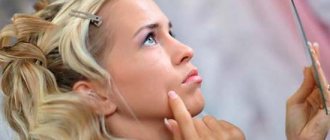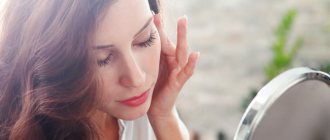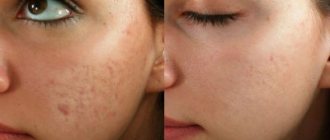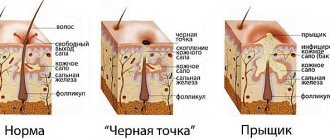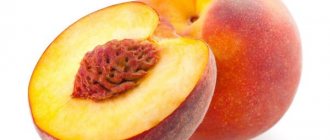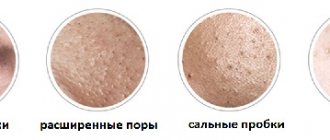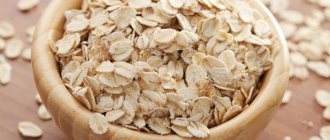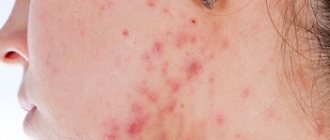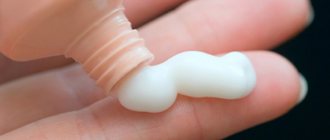Why does it appear
Papulopustular form of acne is the most common. It occurs against the background of existing closed and open comedones, which have been left without treatment for a long time.
Comedones appear due to poor skin care and the accumulation of large amounts of sebum in the sebaceous gland. This causes plug formation and hyperkeratosis.
The work of the sebaceous glands can be increased for a variety of reasons. But more often it is a hormonal imbalance, which happens during the transition period.
The gland begins to produce a large amount of secretion, which is called fat. The process of desquamation of the epithelium on the skin also accelerates. All this leads to the appearance of comedones.
And although the ducts of the gland are closed by a sebaceous plug, it continues to work. And fat that cannot come out accumulates inside. It stretches and a cyst forms.
If a microbe gets here at this time, an abscess will begin to develop, which is called a pimple. When there are both papules (comedones) and pustules (pimples) on the face, this condition is called papulopustular acne. And this variant of acne occurs most often.
Prevention and prognosis
In order not to encounter acne from adolescence, you need to carry out comprehensive prevention, which is aimed at normalizing the functioning of the sebaceous glands. Preventive measures include:
- proper nutrition and adherence to an appropriate diet;
- regular consultations with a dermatologist;
- external use of cosmetics containing zinc;
- physical activity.
In addition, you must take proper care of your skin. If a person has a tendency to develop such a disorder, it is imperative to choose the right cosmetics.
The prognosis depends on many different factors, in particular, such as the cause of occurrence, the age of the patient, and characteristics of the body. Acne is a chronic pathology, which is why it is difficult to treat and prone to relapse. If the disease is very complex, the skin cannot be returned to its ideal condition.
Provoking factors
For both pustules and papules to appear on the body, several factors must work simultaneously.
- The work of the sebaceous glands will increase. They must produce quite a lot of secretion - fat, which does not have time to come out and is retained inside the gland duct.
- Follicular hyperkeratosis is necessarily present , in which the upper layer of skin, the epidermis, begins to grow excessively. Its cells do not have time to exfoliate, as is normal, and close the hair follicles and skin pores.
- Bacteria begin to become active , causing acne. This is Propionibacterium acnes - the main culprit of acne. And also staphylococcus. Normally, they are always present on the surface of the skin, but do not cause any inflammatory process. And only in the presence of an unfavorable factor do they begin to actively multiply and cause an inflammatory process.
For these pathological processes to start, there must be some kind of malfunction in the functioning of the human body. And more often than not, this is the same hormonal change that teenagers go through.
Dermatologists diagnose acne in 80% of all adolescents, including the papulopustular form, which is the most common.
If a rash of the same shape appears in adults, then the cause must be sought in problems with the endocrine system.
Conglobate
This is one of the most complex types of acne, which can multiply throughout the body. Pimples are multiple reddened follicles that grow together between nearby sites of infection.
Typically, inflammation grows on the body of an adult male, due to increased testosterone levels and steroid use. If you have this disease, you should immediately consult a doctor to avoid worse consequences.
In addition to the main types of acne, acne also occurs in young children. Types of such neoplasms are called Infant or Children's acne. When inflammatory processes appear on the body, it is necessary to undergo a full course of tests to identify the causes of the disease.
Acne always requires treatment from a doctor or at home. To understand what types of acne you can treat on your own, you need to know the degree of their development. There are only 4 stages of neoplasms, of which only stage 1-2 can be treated at home. Next, you need professional help from a specialist.
Acne cream: TOP 3 best products and comparison of their effectiveness. Tips from dermatologists on how to get rid of acne (125 photos)Pimples broke out: finding the cause, choosing a remover, tips and the best skin care products (70 photos)
Anti-acne masks - composition, application, contraindications, advice from cosmetologists on application and mask recipes for home treatments (130 photos and videos)
Symptoms
Papulopustular acne is two types of elements on the skin. First of all - pustules or pustules. As well as papules or nodules. All of them can be up to 5 ml in diameter and significantly disrupt the emotional state of a young person.
Papules or nodules do not have a cavity inside. They are dense and appear in the epidermal or papillary layer of the skin. They can be inflammatory or non-inflammatory.
Pustules are always filled with pus. May be superficial or deep. If an abscess appears in a hair follicle, a staphylococcal infection can be diagnosed. These pimples resemble the cone of a volcano. The diameter varies - from one to five millimeters.
If the pimple is located on the surface, then after treatment it does not leave scars or other changes. In some cases, the skin color may change in this area and a spot may appear.
A deep acne that is located in the dermis can spread even deeper without treatment. Now the disease will no longer be called acne, but a boil or carbuncle. And after such formations, rough scars always remain.
Papulopustular acne has a red inflammatory color. But if the disease is not treated, the color of the rash may change to bluish.
This type of rash is classified as mild (with a small number of rashes) or moderately severe.
It can be treated quickly and with the most affordable medications. This is the main difference between papular-pustular rash and conglobate or inverse acne.
Types of acne
To treat a skin disease, you need to know a specific description of individual types of acne. In nature, there are a huge number of varieties and classifications of acne, let’s look at most of them.
- Comedones.
- Papular.
- Pustular.
- Nodal.
- Abscessing.
- Phlegmonous.
- Conglobate.
We will consider a description of these types of acne below, as well as methods for treating acne.
How it develops
Each pustule (ulcer) goes through certain stages of its development.
First, a small red nodule appears that begins to itch. After 2–3 days, pus accumulates in it and because of this, the nodule begins to protrude above the skin. Its name now is infiltration. It becomes painful and causes a lot of inconvenience.
Then the abscess is either opened and cleaned, or a yellow crust appears, which then disappears on its own without developing a scar.
But this only happens if the abscess has not affected the deeper layers of the skin. Sometimes, in order to open it and squeeze out the pus, you have to contact a surgeon. And after surgery, there is a high probability of a scar or an unsightly scar appearing.
Most often, papulopustular acne appears in the following areas:
- On the face.
- Upper back.
- Chest and décolleté area.
- Perineum and groin area.
The severity of the disease is determined by the number of elements present.
If there are no more than 10 pimples, then this is a mild degree.
When there are from 10 to 40 pimples, it will be of medium severity.
If there are more than 40 acne, there are both papules and pustules, as well as cysts that tend to unite, this is already a severe degree.
Causes of acne
The main types of acne cannot occur without a reason, so you should find them in order to be cured in time. The main reasons for the appearance of bumps:
- Hormonal imbalance: adolescence, pregnancy, taking medications.
- Diseases of the gastrointestinal tract: gastritis, ulcers, cancer and so on.
- Poor quality food: 1-2 times a day or fast food. A normal person needs to eat 5-6 times a day, including snacks.
- Poor hygiene or complete lack of it.
- Unprotected skin from external factors: ultraviolet radiation, drafts, cold.
- Failure due to skin contact with chemicals.
- Poor quality cosmetic products.
- Infections inside the body.
- Depression and stressful situations.
Diagnostics
Papulopustular acne is diagnosed by a dermatologist during an examination of the patient. Before prescribing treatment, differential diagnosis must be carried out. This will eliminate purulent skin lesions caused by other microorganisms.
In order to select adequate antibacterial therapy, the doctor may conduct the following studies:
- Carrying out bacteriological culture of the abscess contents to determine which microbe caused the inflammation. This will help prescribe antibiotics that will be sensitive specifically to the microbes that caused inflammation in you.
- You can get tested for hormones , especially if the disease appears in middle-aged or elderly women.
- If necessary, the doctor may recommend a urine and blood test to identify hidden diseases of the internal organs. In some cases, their symptoms will manifest themselves as pustular rashes on the face.
After an accurate diagnosis is made, the dermatologist prescribes treatment. Self-medication for papulopustular acne is unacceptable, as it can cause the formation of boils and carbuncles.
How to get rid
Treatment must be comprehensive and strictly individual. What suits one teenager may not suit another. It is also necessary to take into account the severity of acne and carry out therapy with both local preparations (creams, ointments or gels) and means for systemic administration (tablets).
It is not recommended to treat papulopustular acne on your own.
Essential medicines. Adapalene + benzoyl peroxide
Treatment begins with those topical medications that are based on adapalene and benzoyl peroxide. First of all, this is a new product in the field of pharmacology, Effezel gel. The medicine should be used only once a day. Apply a thin layer to the entire surface of the skin that is covered with acne.
The second most effective medicine is adapalene. It belongs to synthetic retinoids. Helps slow down the process of desquamation of epithelium from the surface of the skin and has an excellent anti-inflammatory effect.
Therefore, with regular use of adapalene, you can quickly eliminate the most important factor in the formation of pimples and blackheads - hyperkeratosis.
Well, benzoyl peroxide helps fight increased secretion of sebum, has a detrimental effect on microbes and bacteria that cause papulopustular acne and reduces the severity of the inflammatory process.
You won't be able to find pure adapalene in a pharmacy. But this substance is included in many medications for external use:
- Adaklin cream.
- Adolen gel.
- Differentin cream.
- Gel klenzit.
- Gel Klenzit S.
The effect of use can be expected no earlier than after a month of daily use. The duration of treatment and the regimen for using a particular drug can only be drawn up by a doctor.
Benzoyl peroxide + clindamycin
A combination drug that includes the above-recommended benzoyl peroxide and the antibiotic clindamycin is a reliable assistant in the fight against acne, including those that appear on the face as a result of papulopustular acne.
Such drugs include the drug indoxyl.
But clindamycin can also be used as a single drug. For example, in the form of gel dalacin.
However, it is better not to use medicine without benzoyl peroxide. Over time, acne bacteria can develop sensitivity to antibiotics and such medications simply no longer help.
This does not happen when used simultaneously with benzoyl peroxide.
Single drugs
In the treatment of acne, monopreparations are also used, in which only one active ingredient is present.
So, for example, the list of drugs with antibiotics that are recommended by doctors will look like this:
- Baziron AS.
- Dalacin gel.
- Erythromycin ointment.
- Skinoren gel or cream.
- Curiosin gel.
The dosage and amount of application once a day is determined only by a doctor. All medications may have some side effects - redness, dry skin, irritation. But they disappear on their own and do not require special treatment.
Doctors prescribe topical acne medications to avoid side effects such as intestinal candidiasis.
The second group includes retinoids for topical use. This:
- Retin - A.
- Differin gel.
- Isotretinoin tablets.
- Tretinoin cream.
- Isotrexin gel.
- Retinoic ointment.
- Will erase the capsules.
- Roaccutane tablets.
- Retasol solution.
- Stieva-A
Only a dermatologist can prescribe retinoids. These drugs have many contraindications and side effects. And the medicine is prescribed only for severe cases of the disease.
Rubbing
To wipe the skin, the doctor may prescribe antibiotic-based alcohol solutions. For example, chloramphenicol alcohol. It is also recommended to treat affected areas of the skin:
- Salicylic acid.
- Camphor alcohol.
- Chatterbox with sulfur.
But only people with oily skin can use such treatment methods. For dry skin, the use of alcohol solutions is contraindicated.
Systemic drugs
If local treatment for papulopustular acne has not produced any results for 3 months, the doctor may recommend taking medications in tablet form.
Tetracycline and doxycycline are primarily used. Doctors recommend avoiding erythromycin, since this drug is quickly addictive and the microbes that cause acne simply stop responding to this medicine.
Whether the prescribed drug helped or did not help can be judged only after 6 to 8 weeks of daily use from the start of treatment.
In addition to the drugs described above, the following can be used for antibacterial therapy of papulopustular acne:
- Flemoxin is a type of synthetic penicillin.
- Lincomycin from the group of lincosamines.
- Clindamycin is also from the previous group.
- Minolexin, which belongs to tetracyclines.
- Vilprafen is from the group of macrolides.
Medicines are taken according to strict dosages without the possibility of self-medication.
Retinoids in tablets
When antibiotics do not provide the desired results, your doctor may recommend using retinoids in tablet form.
Most often, preference is given to a drug called isotretinoin. It is prescribed only when other medications are clearly ineffective, as well as when the skin is prone to the formation of pimples and blackheads.
The second medicine from this group is Roaccutane. It is widely used in the West and in the USA and gives excellent results.
But retinoids in tablet form have many contraindications. Therefore, self-medication should be completely excluded.
Contraceptives
Papulopustular acne in women can also be treated with contraceptive medications. the most popular and frequently prescribed are Diane - 35, Janine and Jess.
The gynecologist can prescribe the medicine after the girl takes a blood test for hormones. Without this blind analysis, doctors rarely prescribe these drugs.
Medical cosmetics
During the treatment of papulopustular acne, it is recommended to use additional skin care. And medicinal cosmetics will do a great job with this.
First of all, in the morning and evening, you need to cleanse your face with gel, foam or balms for washing. It is important that they are natural based and do not contain alcohol. The ideal option is aloe vera in the composition.
Then you need to apply a good moisturizer to the skin that does not have a comedogenic effect and does not clog pores. Ideal options for skin care include cosmetics:
- Green Mama.
- Garnier is known for its television commercials.
- Black Pearl.
- A-Derma.
- Exfoliator from France.
- Bioderma.
- Merck.
- Klorane.
- La Roche-Posay.
- Vichy.
It is best to purchase these cosmetics at a pharmacy or from a sales representative. It is not recommended to buy creams, gels, foams on the market, as you can buy low-quality fakes.
Traditional methods of treatment
Unfortunately, it is impossible to eliminate papulopustular acne using traditional methods of therapy alone. but these recipes can be used in conjunction with other methods of therapy - taking pills, using a gel or cream.
The ideal option is to use fresh aloe juice and pulp. Even dermatologists say that this method helps get rid of minimal manifestations of acne, and will also significantly rejuvenate the skin and help avoid the early appearance of wrinkles.
Additional treatments
To quickly get rid of pus in pustules and get rid of papules, a dermatologist may advise you to consult a cosmetologist.
For example, cryotherapy has a good effect. 3 times a week, areas where acne appears should be treated with liquid nitrogen. As a result, inflammation decreases and the amount of sebum secreted decreases.
Electrophoresis with ichthyol may help. But this procedure is recommended for those who have very large acne and are located almost all over the body.
Ichthyol ointment for acne has a good effect. It should be used pointwise - applied to papulo-pustular acne, covered with gauze and secured with adhesive tape. This simple method can draw out pus.
How to treat post-acne
After papulopustular acne of moderate and severe severity, scars, cicatrices and age spots remain. Their treatment is an important point in the fight against acne. But therapy to eliminate these elements can be carried out only after the inflammatory process has completely stopped.
Post-acne treatment is carried out using different methods. First of all this:
- Dembrasia.
- Superficial chemical peeling.
- Ozone therapy.
- Phototherapy.
- Laser therapy.
- Mesotherapy.
The drug imoferase has a good effect, which helps get rid of even severe post-acne.

